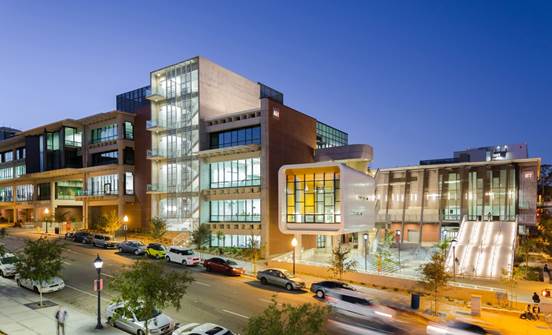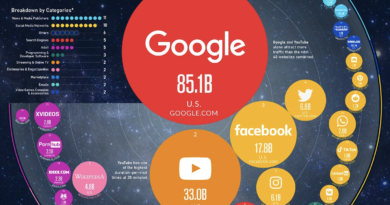Daily Business Report-Sept. 18, 2018
San Diego City College Arts & Humanities Building, one of 36 new classroom buildings completed as part of the Propositions S and N bond construction campaign, which is nearing completion but will still account for approximately $60.8 million in expenditures in 2018-19.
College district’s $679 million budget
is first under state’s new funding formula
The San Diego Community College District’s (SDCCD) Board of Trustees has adopted a balanced budget of $679 million for the 2018-19 fiscal year that is the first for the district under a paradigm shift in state funding for the California Community Colleges system.
The district’s budget reduces overall spending by more than $48 million – or approximately 7 percent – as the Propositions S and N bond construction program winds down following the completion of construction projects.
Unlike previous years, in which the state’s approximately $6.7 billion in general funding for community colleges was based almost entirely on enrollment figures, the 2018-19 budget is the first under the California community colleges new “Student Centered Funding Formula.” The formula accounts for such metrics as community economic factors, the percentage of low-income and underrepresented populations, degree and certificate completion, the persistence of achievement gaps, and the numbers of students transferring to University of California and California State University campuses.
General fund spending totals just under $448 million, and general fund spending not restricted to certain programs is holding steady at just under $312 million. Expenses not in the general fund, which include areas such as federal financial aid ($77 million), Propositions S and N bond measure funding ($60.8 million), capital improvements ($23.3 million), and retiree benefits ($20.3 million), comes to a total of $231.6 million.
_____________________
Alliance Healthcare Foundation
announces $2 million innovation initiative
San Diego’s Alliance Healthcare Foundation announced the establishement of a $2 million innovation fund at the San Diego Foundation aimed at improving health care in the commuity, with a focus on prevention in underserved areas.
The $2 million is split evenly between two San Diego nonprofit organizations:
1. Multicultural Health Foundation to form the Prevention Alliance, which aims to reduce the disproportionately high rates of diabetes in communities of color. Through invocative outreach approaches, the project will bring diabetes prevention services to 8,500 San Diego residents.
2. Somali Family Service for its Refugee Vaccination Education program, which focuses on increasing vaccination rates among East African residents living in San Diego County. Currently immunization rates in this community are well below the national average, placing children and adults at greater risk for several serious, and potentially life-threatening diseases.
_____________________
Cal State San Marcos wins HEED
Award for fifth straight year
California State University San Marcos has received the 2018 Higher Education Excellence in Diversity (HEED) award from INSIGHT Into Diversity magazine, the oldest and largest diversity-focused publication in higher education. This is the fifth straight year that CSUSM has been named a HEED Award recipient.
As a recipient of the HEED Award — a national honor recognizing U.S. colleges and universities that demonstrate an outstanding commitment to diversity and inclusion — CSUSM will be featured along with 79 other recipients in INSIGHT Into Diversity magazine’s November 2018 issue.
Cal State San Marcos is one of six CSU schools to win the HEED Award this year. The others are East Bay, Fresno, Fullerton, Los Angeles and Northridge.
_____________________
FEMA postpones nationwide test
Update: FEMA has postponed the nationwide tests originally scheduled for Sept. 20 to Oct. 3 due to the ongoing response efforts to Hurricane Florence in parts of North Carolina and South Carolina. Your mobile phone will emit a special tone and vibrate as it receives an emergency test message on Oct. 3. It is part of a nationwide test by the Federal Emergency Management Agency of Wireless Emergency Alerts systems to assess its effectiveness. For details, visit County News Center.
_____________________
USAF completes first automatic
landing of a General Atomics drone
On August 7, the U.S. Air Force completed the first-ever automated landing of an MQ-9 Block 5 Remotely Piloted Aircraft (RPA), followed by the first auto-takeoff on Aug. 9. The new Automatic Takeoff and Landing Capability (ATLC) was developed by General Atomics Aeronautical Systems Inc. (GA-ASto enhance mission capability.
“This new, all-weather capability greatly increases the autonomy, flexibility, combat effectiveness and safety of the MQ-9 Reaper for the USAF,” said David R. Alexander, president of aircraft systems. “Adding this level of automation will reduce the deployment burden of the warfighter and expand the scope of missions that can be flown by Air Force MQ-9s.”
By automating the takeoff and landing of the aircraft, ATLC helps to increase the safety and efficiency of the air crews. The auto launch and recovery during these critical phases of flight also enlarges the operational envelope for cross wind operations. The ATLC development program remains on track for fielding in the fall of 2019.
_____________________
Qualcomm shares software platform
to identify illegal, stolen devices
Qualcomm Technologies Inc., a subsidiary of Qualcomm Inc., announced it has shared its Device Identification, Registration, and Blocking System (DIRBS) platform as freely downloadable open-source software.
Qualcomm Technologies’ DIRBS server-based software platform can be used to help identify counterfeit, illegal, and stolen mobile devices in a country. The DIRBS software platform will help regulatory agencies classify devices and generate IMEI-based lists for notification, amnesty, and blocking purposes. DIRBS has been successfully deployed in Pakistan, and deployments are anticipated in several other markets in the coming months.
_____________________
MiraCosta College professor honored
for inspiring students to excel in life
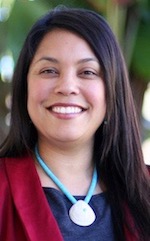
Maria Figueroa, co-coordinator of the MiraCosta College Puente Project and the first person of color to serve as president of the MiraCosta College Academic Senate, has another honor to add to her long list of accomplishments: 2018 Maestro Award recipient. The Maestro Award recognizes exemplary instructors who go above and beyond the duties of a teacher to serve as a creative mentor and activist dedicated to multicultural education. It is bestowed by Latino Literacy Now, a nonprofit co-founded by award-winning actor and community activist Edward James Olmos.
Figueroa received the Maestro Award on Saturday at the 65th Latino Book and Family Festival at MiraCosta College’s Oceanside campus. Produced by Latino Literacy Now, the Latino Book and Family Festival was launched in Los Angeles in 1997 and has since become a sought-after event that promotes literacy, culture and education.
The English professor has been teaching for more than two decades. She has spent more than half of her career as a leader with the Puente Project, a hugely successful initiative emphasizing English composition, counseling, and mentoring to boost the numbers of disadvantaged youth who enroll in and graduate from four-year colleges and universities.
_____________________
Ensysce Biosciences awarded $4.3 million
for opioid overdose protection platform
Ensysce Biosciences Inc. in San Diego has been awarded a four-year contract to undertake the pre-clinical and clinical development of the company’s opioid overdose protection platform MPAR (Multi Pill Abuse Resistance). The first two years of the grant will provide $4.285 million to complete the IND enabling studies to bring the first MPAR overdose protection product into clinical studies in the U.S. With the IND submission, additional funds of up to approximately $5 million will be available for the Phase 1 clinical trial.
_____________________

Introducing the five new
S.D. County Teachers of the Year
Five local educators were named San Diego County Teachers of the Year during the 28th annual “Cox Presents: A Salute to Teachers,” sponsored by San Diego County Credit Union (SDCCU) in partnership with the San Diego County Office of Education (SDCOE).
The 2018-19 San Diego County Teachers of the Year are:
• Stephanie Glanz, Rose Elementary School, Escondido Union School District
• Sesha Haynes, Sweetwater High School, Sweetwater Union High School District
• Melissa Moreno, Rosebank Elementary School, Chula Vista Elementary School District
• Jose Villegas, Nestor Language Academy, South Bay Union School District
• Katie Wu, Westview High School, Poway Unified School District
The five Teachers of the Year will represent San Diego County in the California Teacher of the Year program. The state winners will be announced later this fall. Since 1974, 171 teachers have been named San Diego County Teacher of the Year. Of those, 22 were named California Teacher of the Year and three went on to be named National Teacher of the Year.
_____________________
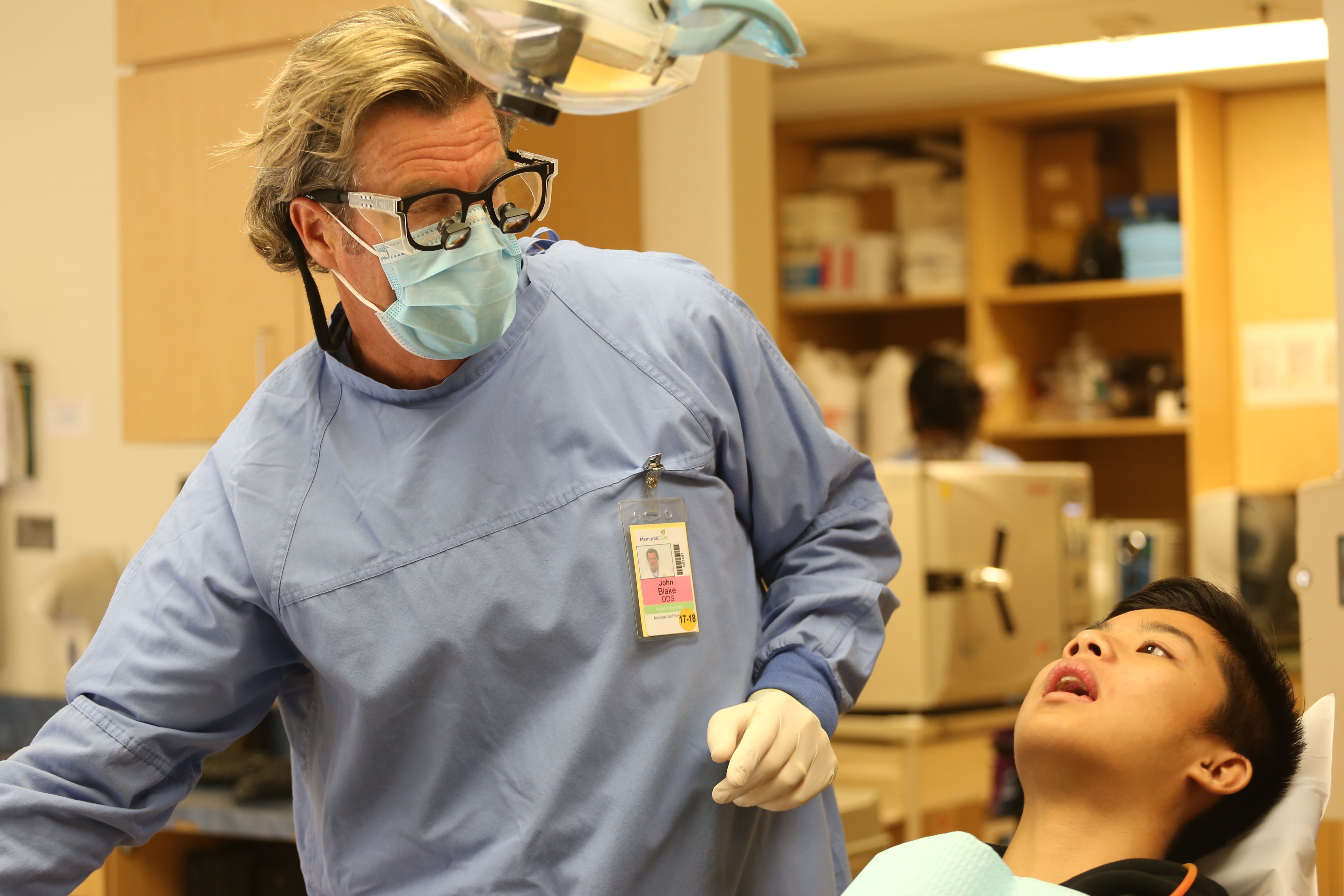
In California, saving teeth and money
—one mouth at a time
By David Gorn | CALmatters
At the children’s dental clinic that Dr. John Blake runs in Long Beach, toddlers come in all the time with problems so severe they need root canals. Children as young as 2 or 3 show up with blackened teeth and swollen faces, unable to eat because of the pain and in need of whole mouth restorations.
“It’s rampant,” Blake said, “and it’s really a disaster to see.”
In California, the state with highest poverty rate, tooth decay in children outpaces the national average. Hoping to save both teeth and money, the state is addressing the problem with an overhaul of Denti-Cal, part of the Medi-Cal health system for low-income Californians.
Pilot programs are underway to get more kids into a dentist’s chair, and the state plans to kick off an educational campaign next month. Officials have also reduced red tape, streamlined billing, raised payments to dentists and offered cash to those willing to accept more state patients.
The moves fit into a larger state focus on prevention as a way to reduce chronic conditions, emergency care, surgeries and the high related treatment costs. Medi-Cal covers about a third of Californians and consumes more than $100 billion annually in state and federal money. Denti-Cal accounts for about 2 percent of that, or just under $2 billion.
Not long ago, Blake said, he was exasperated by the state program; some of its payment rates were “almost comically low.” His nonprofit clinic had mostly Denti-Cal patients, and he needed private donations to fund about half of his operating expenses. The system was a constant hassle, with unnecessary paperwork and delayed payments.
“I was one of the fiercest critics of Denti-Cal,” Blake said. “I can remember sitting before the Legislature and telling them, ‘This is not a functional program.’ ”
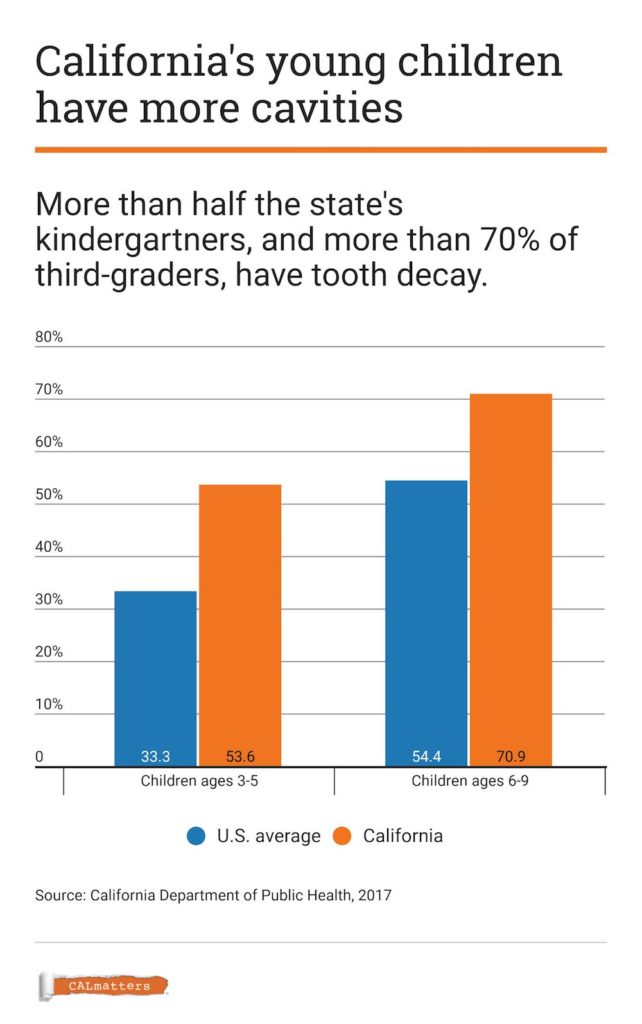
But in the past few years, the state has aside money for rate increases—$210 million in the current budget. It has also signed up hundreds more dentists, expanded the number of patients seen by individual providers and placed new emphasis on prevention, according to the California Department of Health Care Services, which oversees Medi-Cal.
“Now I have to give them some praise,” Blake said. Almost all of the problems and possible solutions he testified about years ago have been addressed or implemented, he said—although he’ll continue fundraising because the increases still don’t meet his costs.
“These changes at Denti-Cal are great….And I can tell you,” he said with a little chuckle, “I don’t think I’ve ever used ‘great’ and ‘Denti-Cal’ in the same sentence before.”
The Little Hoover Commission, a state oversight panel, has also pushed for change. It initiated public hearings in 2015 to examine Denti-Cal’s rock-bottom utilization rates—at the time, only a third of enrolled children ages 3 and younger had seen a dentist in the previous year. The commission issued a damning report in 2016 that called the system “broken” and one of the state’s “greatest deficiencies.”
“It’s not there still,” Blake said, adding that payments now are about 30 percent of what he’d get from private insurance—better than the 25 percent or so he used to get, but not enough. And “paperwork is still a factor,” he said.
Signing up dentists with a negative view of Denti-Cal has been a big challenge for the department. But the latest data shows a turn. A recent report from the Department of Health Care Services says that, from July 2017 to March 2018, 360 new providers joined Denti-Cal, bringing the participant total to nearly 10,000.
And from 2014 to 2016, the department reported, the number of dentists seeing 10 or more Denti-Cal children rose by more than 6 percent, which means roughly 400 more dentists across the state have expanded their practices to include more low-income kids. Cash bonuses go to those who expand their Denti-Cal load by 2 percent, a target that will grow to 10 percent over five years.
In addition, the state has:
• Expanded teledentistry efforts, allowing providers to supervise some care remotely, increasing their availability to underserved areas.
• Switched to electronic billing and trimmed paperwork requirements.
• Begun testing ways to reach more patients and offer better preventive services, through the pilot programs across California. In Sonoma County, for instance, the goal is to eliminate new cavities in 75 percent of children within five years.
• Appointed a state dental director, Jayanth Kumar, charged with reducing oral-health disparities in California and developing a statewide oral-health plan in coordination with multiple government agencies.
Harvey Lee is chief dental officer for the nonprofit Healthy Smiles for Kids, which provides care to low-income children in Orange County. He said the Denti-Cal changes helped convince him to treat low-income youngsters, outside of his fee-for-service practice in Irvine.
He had heard “the nightmare stories of waiting for six months to get approval” as a provider, … and the red tape, … submission of X-rays and so forth just to get pennies on the dollar.”
But he was approved in a week. A Denti-Cal representative even came to his office to help with his application. Lee said the payments aren’t as high as what he gets in private practice, but “the increase helps.”
“Most dentists just know the old Denti-Cal, but they don’t know the little nuances in how it was improved,” Lee said. He’s treating a high volume of Denti-Cal patients through teledentistry.
With that kind of innovation, said Alani Jackson, chief of dental services at the Department of Health Care Services, “it’s like we’re riding the right wave of change.”
The main goal of the system overhaul is to establish a dental “home” for patients, where one dentist coordinates care for an individual or family. That can help lead to a lifetime of better oral health, Jackson said. And lower costs for the state.
In particular, the department is focusing on children six and younger. Jackson said the pilot program in Orange County includes presentations at schools. “We’re going to where the kids are,” she said.
There’s still work to do, Jackson and her staff acknowledge. And their successes must be maintained for the long term. Katie Andrew, Oral Health Senior Associate at Children Now, a nonprofit health advocacy group in Sacramento, agreed.
“For patients,” Andrew said, “this hasn’t been a dramatic change. Many still don’t know about Denti-Cal benefits, and in the rural counties especially, there just aren’t enough providers.”
Blake said it will take “many years to rebuild that system of care and earn back the trust of California’s dentists…..Many dentists are waiting in the wings to see if this can be sustained.”
Meanwhile, Lee expressed surprise at how much it means to him to care for low-income, high-need patients.
“I never really thought I’d enjoy this part of being a dentist,” Lee said. “But it’s wonderful. I mean, you’re not doing it to make money, you do it because there’s a need.”
CALmatters.org is a nonprofit, nonpartisan media venture explaining California policies and politics. This is the fifth article in a series on state efforts to foster healthy living as a way to reduce chronic illness.

